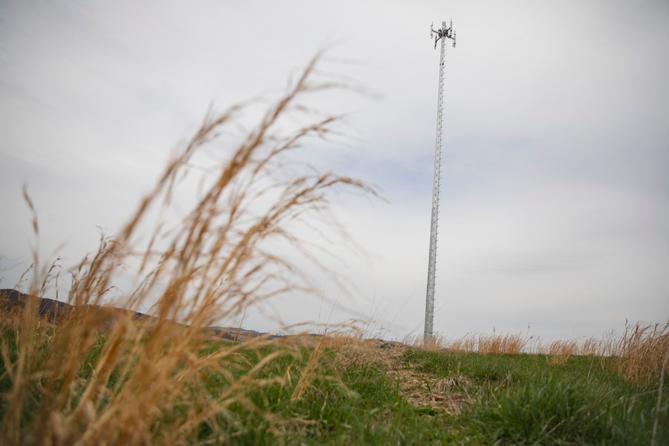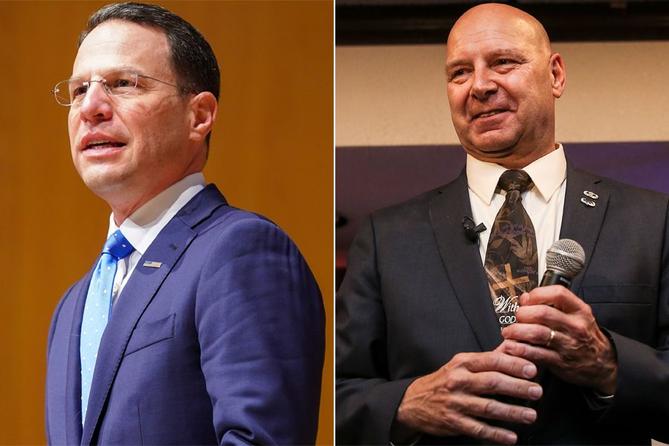Spotlight PA is an independent, nonpartisan newsroom powered by The Philadelphia Inquirer in partnership with PennLive/The Patriot-News, TribLIVE/Pittsburgh Tribune-Review, and WITF Public Media. Sign up for our free newsletters.
HARRISBURG — People who live in rural Pennsylvania face unique barriers to health care, broadband, and economic opportunities.
About 3.4 million people, or roughly 26% of Pennsylvania’s residents, live in the commonwealth’s 48 rural counties, according to the Center for Rural Pennsylvania, a state agency.
Pennsylvania’s governor has the authority to address a wide range of rural issues. On Nov. 8, voters here will choose from among five candidates for governor including frontrunners Democratic Attorney General Josh Shapiro and Republican state Sen. Doug Mastriano of Franklin County.
Both major candidates offer different approaches to revitalizing rural Pennsylvania. Spotlight PA breaks down where they stand on several major issues.
Health care
In Pennsylvania, access to health care in rural regions is narrowing as some hospitals like the Bradford Regional Medical Center drastically reduce services, and others shut down.
There is limited access to other health services like mental health and addiction treatment, studies from the Center for Rural Pennsylvania show. Emergency services are also struggling to get people the care they need in time. Maintaining the health care workforce also remains a challenge, as hospitals struggle with staffing shortages.
Both candidates support promoting access to telemedicine. Mastriano has supported a bill that would do so, and Shapiro voices support for expanding access to telemedicine on his campaign website.
Mastriano also supported and voted for Peyton’s Law, which helps inform student-athletes and their parents about the importance of testing to identify heart conditions that can lead to sudden cardiac arrest, which is crucial in rural communities due to limited access to emergency services.
Mastriano is also one of the lead sponsors of a bill that would cap insulin pricing, which pertains to people in rural areas because they face higher risk factors for diabetes and have access to fewer services.
Shapiro has advocated for affordable health care in rural communities and said he would “strengthen the pipeline for healthcare providers in under-served areas” on his campaign website.
In 2007, when Shapiro was a state representative, he proposed a bill that would forgive doctors’ medical school loans if they stayed in Pennsylvania for at least 10 years.
Shapiro’s campaign told Spotlight PA that he will expand the Student Loan Relief for Nurses Program for every qualifying nursing student. The plan would double the amount of relief provided by up to $15,000 in loan relief, and provide full loan forgiveness to nursing students who choose to practice in a state-identified underserved community for five years.
Shapiro said he also supports initiatives like the Pennsylvania Rural Health Model, which is an alternative payment structure funded by the Centers for Medicare & Medicaid Services that tests whether hospitals can improve their finances and services on fixed budgets. Currently, 18 Pennsylvania hospitals participate in the model.
In addition, Shapiro has promised to restore Pennsylvania’s Emergency Medical Services Operating Fund, which partially funds EMS across the commonwealth, and has said he will work with legislators to rein in drug prices.
As attorney general, his office sued the University of Pittsburgh Medical Center health system to push them to reach a deal with Highmark health insurance. The dispute between the health care companies could have cut off thousands of patients from 11 UPMC hospitals, many of which are in rural regions of the state.

Broadband
At least 13% of rural Pennsylvanians don’t have broadband access, according to the Federal Communications Commission, but federal funds provide the state with an opportunity to build the infrastructure needed to support access.
In September, Gov. Tom Wolf, a Democrat, announced that $500 million from the American Rescue Plan Act will go to local governments to invest in infrastructure, including broadband.
Up to $1 billion of federal funding can potentially be spent on broadband expansion. However, a 2004 law restricts local governments from building their own broadband networks, limiting how much of that infrastructure money will actually go toward expanding access.
Shapiro’s campaign told Spotlight PA that he will prioritize expanding quality and affordable access to broadband in rural regions of the state by supporting the newly created Pennsylvania Broadband Development Authority, and establishing comprehensive subsidies for low-income households with high internet prices.
Shapiro was also part of a bipartisan coalition of attorneys general who in 2017 opposed a petition from the broadband industry to stop states from enforcing false advertising laws on internet speeds.
Mastriano did not respond to questions about his position on broadband, but in a March press release, he reported grant funding of more than $800,000 that would go toward expanding high-speed broadband internet in Franklin County.
Workforce development
Pennsylvania’s population is projected to become more urban and less rural by 2040, according to a 2014 study by the Center for Rural Pennsylvania.
Outward migration from rural areas and the contraction of traditional industries such as manufacturing, present ongoing challenges for rural Pennsylvania’s workforce.
The Center for Rural Pennsylvania surveyed 9th- and 11th-grade students in rural school districts in 2021 and found that “few students reported being satisfied with current job opportunities or chances to get ahead in their local communities.”
Pennsylvania’s state government has workforce development initiatives and programs in many departments, including Wolf’s Manufacturing PA Training-to-Career Grant Program, which works with “local manufacturers to identify and teach missing essential skills for entry level applicants,” according to the administration.
“Pennsylvania commits less money to apprenticeship programs today than we did under Governor Casey,” Shapiro’s campaign told Spotlight PA. “As Governor, I will direct the State Board of Education to prioritize vocational education … I will also create an independent Office of Economic and Workforce Development that will collaborate directly with businesses to help them recruit the next generation of talented young workers and triple the total number of apprenticeships statewide.”
In 2021, Mastriano voted for SB 486, which would amend state law to establish a unified workforce investment system and provide grants on job training as well as industry partnerships. The bill awaits consideration in the state House.

Agriculture
Pennsylvania’s $81.5 billion agriculture sector supported 301,900 jobs and $14.5 billion in labor income in 2019, according to the state Department of Agriculture.
Rising prices for equipment and fertilizers have become financial burdens for farmers, forcing smaller farms — often owned and operated by families — to close in recent years.
A member of the state Senate Agriculture & Rural Affairs Committee, Mastriano voted for the 2019 Pennsylvania farm bill both in committee and on the state Senate floor. The legislation, the first state-based farm bill in the nation, passed with bipartisan support.
The Wolf administration touted the bill for creating the Pennsylvania Agricultural Business Development Center, funding programs to expand the state’s processing capabilities, and providing the agricultural industry with incentives to invest in farming.
Mastriano is one of the lead sponsors of a bill that would amend the Agricultural Area Security Law to increase funding for the Agriculture Conservation Easement Purchase Program and ease eligibility requirements so more farms can participate.
He called the proposal “crucial to maintaining food security and protecting against supply chain instability for the commonwealth and our nation.”
Mastriano published a “Plan to Put PA Farmers First” on Twitter, where he said he will end school property taxes to help lower farmers’ tax burden, preserve farmland, slash state regulations in the agricultural sector, and support the state’s dairy industry.
While eliminating property taxes is a popular proposal, to replace the lost revenue for schools under his plan — a nearly $13 billion cut, according to the Pennsylvania State Education Association — Mastriano told WRTA in March that Pennsylvanians will face “a modest increase in sales tax and income tax.”
Both candidates say they will increase dairy processing capacity in Pennsylvania, although through different means. Mastriano wants to do so by reducing red tape, while Shapiro wants to provide tax incentives to businesses.
Shapiro told Spotlight PA that he will help lower the cost of farming production by updating Pennsylvania’s low-interest loan and grant programs and helping farmers more easily receive direct support. Shapiro also said he will provide tax incentives to attract new dairy processing facilities to Pennsylvania.
Read our complete coverage, plus key dates, campaign finance data, sample ballots & more at our Election Center 2022 website.
Spotlight on the Issues: Where Mastriano and Shapiro stand on:
» College Funding & Student Debt
» Abortion, Medicaid, & Opioids
» Rural Health Care & Broadband
A complete listing of Spotlight PA voter guides:
» Your complete guide to voting in the Nov. 8 election
» Everything you need to know about mail ballots
» Your complete guide to the candidates for governor
» How to vet the candidates on your midterm ballot
» No constitutional amendments on the ballot, but big ones loom
» How to serve as a poll worker on Nov. 8
» These Pa. voters haven’t missed a Nov. election for 50+ years
» How Spotlight PA will cover Pennsylvania’s 2022 election
En Español:
» Una guía básica para investigar a los candidatos
» Cómo trabajar como trabajador electoral el 8 de noviembre
» Todo lo que necesita saber para votar por correo
» Su guía completa de los candidatos a gobernador
WHILE YOU’RE HERE… If you learned something from this story, pay it forward and become a member of Spotlight PA so someone else can in the future at spotlightpa.org/donate. Spotlight PA is funded by foundations and readers like you who are committed to accountability journalism that gets results.
